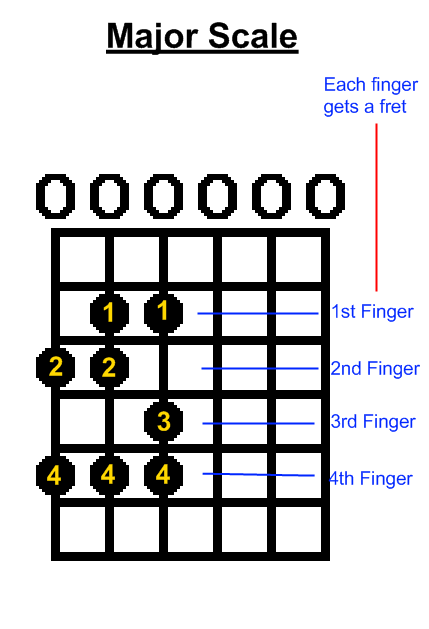Major Scale
Lesson Goals:
♦ Learn proper fingering for major scale
♦ Identify the root note of the major scale
♦ Visualize the scale pattern
In this lesson we will learn the major scale. Previously we discussed the fact that a "major" chord is the parent chord of the other chords of the same name. The same is true for scales. The major scale is the parent scale for all the other scales of the same name. That is why we learn this one first.
Let's take a look at the diagram below.

The dots on the diagram, just like chord diagrams, represent the notes you will play. You will start on the lowest note which is on the 6th string (low "E" string) and play the notes in ascending order using the fingering as indicated by the yellow numbers on the dots. (Note: You should begin on the 6th string with your 2nd finger) Remember - each finger gets a fret.
Pick any spot on the guitar neck from the 2nd fret on up and try to play the scale (anywhere you like). Just pick all the notes with down pick strokes and go slowly. The progression of notes should sound familiar. Just remember back to grade school music class when we had to sing:
"do-re-mi-fa-so-la-ti-do"
Congratulations! You have just played your first major scale. We are not even concerned at this stage which major scale you played. The really important thing is to remember the scale pattern.
Now let's look at the next chart.

It is important to note that in this diagram, the white numbers on the dots represent the steps in the major scale and NOT the fingering!
Step #1 of the scale is the first note that you played with your 2nd finger on the 6th string. This is the lowest note on the scale and the foundation. It is called the "root note". Remember our discussion on chord root notes? Scales have root notes as well.
Step #8 is the "octave" of the root note. It will be of the same name as the root note. For example, if the root note on Step #1 is an "A" note then the note on Step #8 would be an "A" note as well, only it will be an octave up from the original "A" root note.

